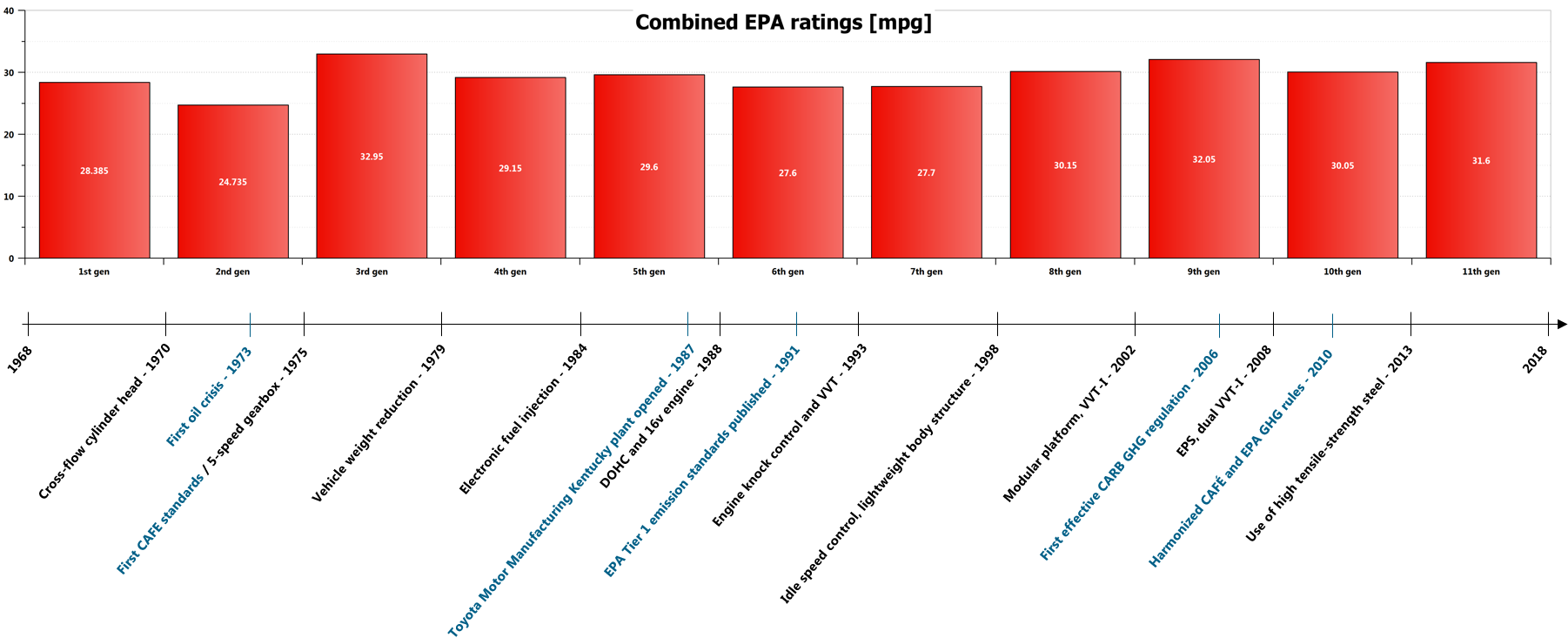Toyota Corolla: retrospective of the world’s most popular car (Part 1)

I recently went through Chris Beves’ post about Formula One aerodynamics history and realized that simulation can do much more than predicting the future. Indeed, it’s also interesting to look at the big picture and understand past evolutions from a macroscopic perspective.
If we consider the automotive industry, which car could better illustrate its trends than the all-time best-seller i.e. the Toyota Corolla?
Starting in 1966, the Japanese OEM has sold more than 45 million Corolla in more than 50 years. In 2019, the 12th generation will be released and is expected to strongly contribute to the continuous sales growth of this iconic family car.
 Toyota Corolla gallery
Toyota Corolla gallery
Looking at these impressing numbers, I decided to build a Simcenter Amesim model and analyze the fuel economy and longitudinal performances of all the models to better understand why this car is so successful. I decided to focus on the US market, considering only the manual transmission variants (knowing that is not the preferred variant in this market, but having more data available) for the sake of simplicity.
Data gathering and Simcenter Amesim model setup
The first step was to gather basic data (engine max power, vehicle weight, tires dimensions, gear ratios …) about each vehicle generations, browsing the web. After some time spent on Wikipedia, Toyota Global site and EPA fuel economy website, I ended up with this Excel file.
 Toyota Corolla Internet data
Toyota Corolla Internet data
Based on these data, and to avoid building a Simcenter Amesim model from scratch, I started from an existing template model which suites well the Toyota Corolla vehicle architecture meaning a gasoline engine with manual transmission and the simulation purposes which are the fuel consumption and longitudinal performances.
 Simcenter Amesim IFP-Drive library demo models (partial list)
Simcenter Amesim IFP-Drive library demo models (partial list)
The model chosen is now opened and ready to be parameterized:
 Simcenter Amesim Toyota Corolla model
Simcenter Amesim Toyota Corolla model
When focusing on the fuel consumption of a car, the core data you need is the engine fuel efficiency map (as a function of the engine speed and load). This map usually cannot be found on the web. Nevertheless, Simcenter Amesim provides a powerful App that allows rebuilding this map based on engine basic parameters: the “engine table creator”.
This App requires simple inputs like max power and torque at given engine speed, type of combustion (diesel, gasoline), engine stroke, number of cylinders, fuel characteristics … The App taps into a database coming from IFPEN research institute and generates max and min torque maps, Brake Specific Fuel Consumption map and some other maps ready to be used in IFP-Drive engine model.
 IFP-Drive engine table creator
IFP-Drive engine table creator
Once the maps are generated for all the engines, we come back to our Excel file and link it to the Amesim model to automatically import other parameters and generate a batch file (automatic successive runs of all the Corolla models). To do so, the Simcenter Amesim Excel Add-in is used:
 Simcenter Amesim Excel Add-in interface
Simcenter Amesim Excel Add-in interface Link between Excel data and model parametersThe batch run parameters file is generated from the Excel sheet and imported into Simcenter Amesim Study Manager.
Link between Excel data and model parametersThe batch run parameters file is generated from the Excel sheet and imported into Simcenter Amesim Study Manager.
Simcenter Amesim simulation results analysis
To compare all the 11 generations of Toyota Corolla, we used 3 different driving cycles:
- The FTP75 used by EPA for giving a typical “city” fuel consumption rating
- The HWFET used by EPA for giving a typical “highway” fuel consumption rating
- A full load cycle to determine the maximum speed of the vehicle
The simulation results are compared for the 3 cycles with the 11 Toyota Corolla generations:
 Simcenter Amesim Toyota Corolla models resultsBy comparing simulation results (blue) with available Internet data (red) for fuel consumption and max speed, it appears that simulation results match quite well with references. It worth saying that data like drag coefficient or fuel consumption may not be available or reliable for old models (1st to 3rd generation) as wind tunnel testing, CFD or standardized driving cycle were not common practices at that time.
Simcenter Amesim Toyota Corolla models resultsBy comparing simulation results (blue) with available Internet data (red) for fuel consumption and max speed, it appears that simulation results match quite well with references. It worth saying that data like drag coefficient or fuel consumption may not be available or reliable for old models (1st to 3rd generation) as wind tunnel testing, CFD or standardized driving cycle were not common practices at that time.
Fuel consumption values are not so much better in the latest generation vehicles than in the old ones. This is mostly due to the increase in the weight of vehicle coming from passive safety improvements as well as additional comfort features like air-conditioning. The emission regulations that have been imposed since the 90’s can also explain a decrease in engine efficiency. Showing the vehicle fuel consumption per tonne allows to better understand these evolutions:
 Toyota Corolla fuel consumption per tonne on HWFET driving cycle
Toyota Corolla fuel consumption per tonne on HWFET driving cycle
Indeed, the powertrain efficiency and aerodynamics of the Toyota Corolla have drastically improved as we can see in the two graphs below: Aerodynamic losses reduction evolution
Aerodynamic losses reduction evolution
 Comparison between K and 2ZR-FE engines BSFC
Comparison between K and 2ZR-FE engines BSFC
Finally, we can also put these fuel consumption figures in perspective with the macroeconomic events that happened in the US market (in blue) and with Toyota Corolla technical evolutions (in black):
 Toyota Corolla fuel consumption evolutionThis concludes the first part of this post dedicated to the iconic Toyota Corolla where Simcenter Amesim has been used to estimate the evolution of its fuel consumption and performances. Taking a step back on the results, it is clear that the improvements done on the powertrain efficiency and aerodynamics have been partly counterbalanced by the vehicle weight increase and the emissions regulations.
Toyota Corolla fuel consumption evolutionThis concludes the first part of this post dedicated to the iconic Toyota Corolla where Simcenter Amesim has been used to estimate the evolution of its fuel consumption and performances. Taking a step back on the results, it is clear that the improvements done on the powertrain efficiency and aerodynamics have been partly counterbalanced by the vehicle weight increase and the emissions regulations.
Do you think the 12th generation will make a quantum leap when it comes to fuel consumption? What should it take? Some possible scenarios are explored in part 2 of this post!


